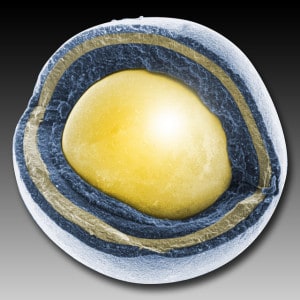Published on Thursday December 19 2013 (AEST)
This clip from the ABC science program 'Catalyst' contains an exclusive look at recent developments in nuclear reactor technology in China. The pebble-bed test reactor is claimed by Chinese scientists to be a safe alternative to more traditional water-cooled reactors and the clip contains a test sequence showing the pebble-bed test reactor avoiding a 'meltdown' test scenario.
Reporter Mark Horstman interviews scientist Professor Wu Zongxin, who explains how pebble-bed reactors operate.
Advances in high temperature nuclear reactor fuel – TRISO integrity at 1800 C!
A safer and more efficient nuclear fuel is on the horizon. A team of researchers at the U.S. Department of Energy’s Idaho National Laboratory (INL) and Oak Ridge National Laboratory (ORNL) have reached a new milestone with tristructural-isotropic (TRISO) fuel, showing that this fourth-generation reactor fuel might be even more robust than previously thought.
TRISO particle – 1 mm diameter
 In the past three years, David Petti, director of the Very High Temperature Reactor Technology Development Office, and his team have studied the safety of TRISO fuel. New insights come courtesy of post-irradiation examination of the fuel, which has been a team effort between INL and ORNL.
In the past three years, David Petti, director of the Very High Temperature Reactor Technology Development Office, and his team have studied the safety of TRISO fuel. New insights come courtesy of post-irradiation examination of the fuel, which has been a team effort between INL and ORNL.
Their findings reveal that after subjecting the fuel to extreme temperatures — far greater temperatures than it would experience during normal operation or postulated accident conditions — TRISO fuel is even more robust than expected. Specifically, the team found that even at 1,800 degrees Celsius (more than 200 degrees Celsius greater than postulated accident conditions) most fission products remained inside the fuel particles, which each boast their own primary containment system.
TRISO particles in matrix
 “The release of fission products is very low,” says Petti.
“The release of fission products is very low,” says Petti.TRISO fuel particles are the size of poppy seeds. Break one open, and it looks like the inside of a tiny jaw-breaker. An outer shell of carbon coats a layer of silicon carbide, which coats another layer of carbon and the uranium center — where the energy-releasing fission happens. Byproducts of the fission process have the potential to escape the fuel, especially at very high temperatures.
To study the fuel under accident conditions, Petti and his team placed six capsules inside INL’s Advanced Test Reactor core, where they were subjected to neutron irradiation. Then, controlled, high-temperature testing of the irradiated fuel in furnaces at INL and ORNL demonstrated that fission product release remains relatively low at high temperatures postulated to occur in accidents and beyond.
“This first series of TRISO test fuel has performed above the team’s expectations, both during its three years in the ATR, and throughout the subsequent high-temperature testing,” says John Hunn, ORNL project lead for TRISO fuel development and post-irradiation examination.
“The ability of the fuel to retain fission products at such high temperatures translates directly to enhanced safety of the reactor,” said Paul Demkowicz, the technical lead for post-irradiation examination of TRISO fuel for the Very High Temperature Reactor program. “This sort of test data is important input for reactor design and reactor licensing.”
He and his team were able to identify the few individual particles that did secrete cesium and isolate them for further analysis. They did this by dissolving the matrix that contained the particles — thousands in each chalk-sized fuel pellet.
“We’ve developed a tool that uses computer-controlled automation to sort through thousands of irradiated particles and identify the rare defects,” said Hunn. “Careful study of these few defective particles, along with the numerous particles that perform well, allows us to complete the TRISO fuel development circle by connecting the fabrication process and material properties to performance in the reactor.”
The insights gained will also “improve our ability to fabricate even better particles in the future,” said Demkowicz.
Petti wants to further explore the fuel particles’ limits. “If the fuel performs well at 1,800 [degrees Celsius], what about higher temperatures?” he said.
This revelation comes 11 years into INL and ORNL’s joint study of TRISO fuel, which began in 2002. TRISO fuel was developed and used in Germany in the 1980s. U.S. researchers have shown that their own version of the fuel can achieve more than twice the burn-up levels — that is, the amount of the fuel that is used to release energy — clocking in at nearly 20 percent burn-up.
 Australian Uranium News - Research
Australian Uranium News - Research


No comments:
Post a Comment